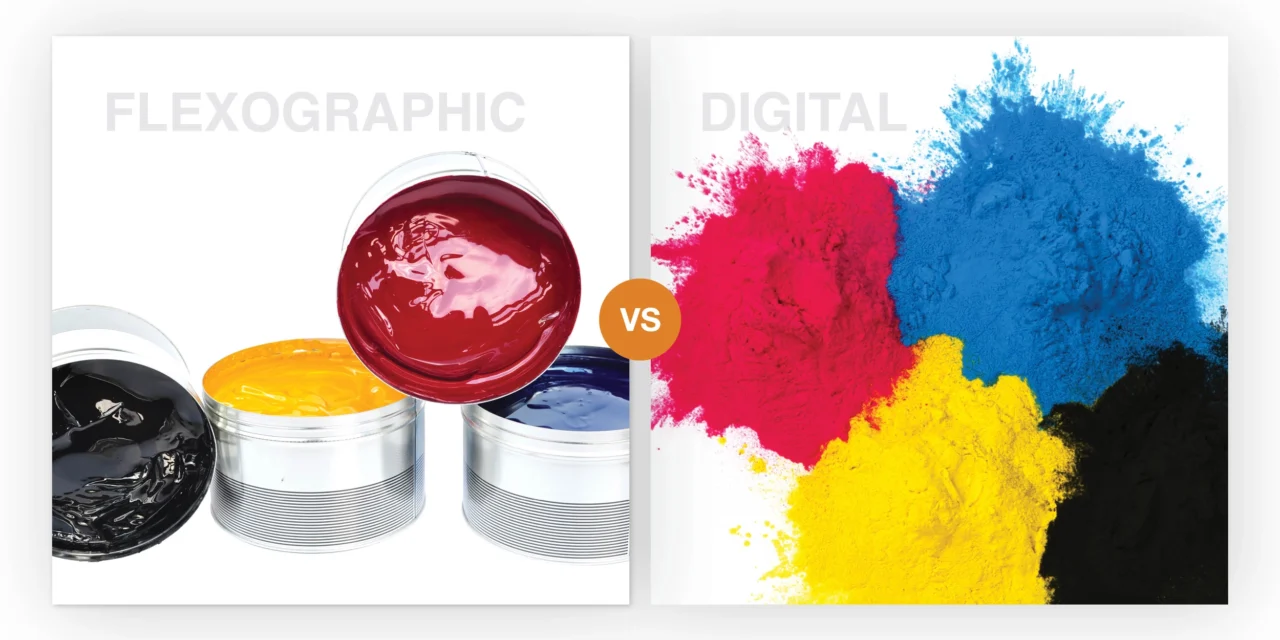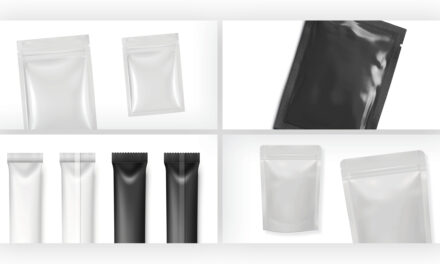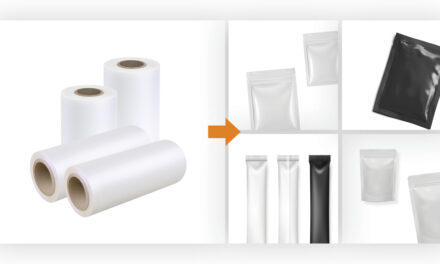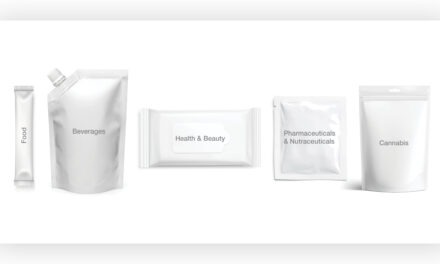CHOOSING A PRESS FOR FLEXIBLE PACKAGING
When selecting which printing method to focus on, newcomers to the flexible packaging industry may be unsure how to find the best balance between functionality and printing capabilities in a quickly changing industry. For this article, we will look at two of the most popular printing methods for flexible packaging: flexographic printing and digital printing. While other printing methods exist, such as rotogravure printing, these two are the most popular by a large margin.
Each type of press has its own benefits and drawbacks, and each printer must ultimately decide for him or herself which type best meets their needs regarding their business goals, experience level, and target markets. Let’s analyze each printing method and take a closer look at why a printer might choose to invest in one over the other.
FLEXOGRAPHIC PRESS
Flexographic presses are large machines that consist of several different stations that perform printing and various other processes. Also called “decks,” each station can accept one ink color, although they can also hold adhesives, lacquers, and other materials depending on the application. Because every flexographic press has a maximum number of stations (usually ranging from 8 to 10), the press is ultimately limited in how many colors and processes it can achieve for each run. Regarding inks, four decks are typically devoted to cyan, magenta, yellow, and black with the ability to set aside one or two decks for specially made colors, also called spot colors, as needed.
On a flexographic press, ink is applied via laser-etched image plates that are placed onto the rotating cylinders at each printing station. These plates are produced in-house with proprietary (and often highly controlled) equipment and can be adjusted as needed to ensure the image matches the proof as closely as possible. Through a series of rollers, the ink in the deck is metered out and applied to the image plate before the image plate transfers the ink to the print web. As the print web is fed through the machine, it receives a separate layer of ink at each deck, with the final result being a beautiful, full-color print.
Of course, since each color and design element is applied in succession instead of simultaneously, it is crucial that the flexographic press be perfectly calibrated and aligned to ensure colors are printed in just the right way to create a crisp design with high color accuracy. This process, called registration, can be very time-consuming for even experienced press operators; for new printers, it is often one of the steepest learning curves in the printing process. Each new SKU or design requires specific plates to be created, and pre-press registration must be performed between runs.
DIGITAL PRESS
Rather than using plates, most digital presses print directly onto the print web. The exact technology used may vary between press manufacturers, with inkjet, dry toner, and laser all being popular options. However, in every instance, the digital press is able to instantly recreate a digital image file without the use of static physical plates through digital mapping.
Regarding pre-press, printers simply use software that is integrated into the digital press to select an image file and then press start. While printers may need to make certain adjustments to account for other steps in packaging production, such as compensating for color shift with thermal lamination, a digital press is capable of perfectly recreating the uploaded image without a lengthy registration process, making pre-press easy and quick in most instances.
Digital presses strictly utilize CMYK color processing, which means they are capable of printing iterations of only four colors: cyan, magenta, yellow, and black. Unlike a flexographic press, a digital press does not allow printers to utilize spot colors for more unique designs. Digital systems typically print ink directly onto the print web instead of using plates. This makes them highly flexible when switching between designs as they can adapt instantly to a new pattern without the need for laser-etched plates.
HOW TO CHOOSE A PRESS FOR FLEXIBLE PACKAGING
Now that we have a general overview of each press type, we should consider what qualities and priorities may lead a converter to choose one printing method over the other. As both press types have their own strengths and weaknesses, converters may have to find the option that meets the majority of their needs and adjust their processes or expectations regarding secondary and tertiary needs. Converters must learn to create high-quality flexible packaging by playing off the strengths of their chosen printing method and properly communicate any limitations or benefits to brands as they become relevant.
Image Quality
While both printing methods are fully capable of producing high-quality graphics that draw in consumers, flexographic presses ultimately offer more flexibility and higher image fidelity than digital presses. In terms of flexibility, flexographic presses enable brands to request a limited number of spot colors, helping ensure that unique brand colors are accurately portrayed on their packaging. Additionally, the polymer plates that are used to transfer ink to the print web help ensure the edges of the printed design are crisp with little blurriness. The harder the plate material, the more precise the edges of a printed design can be, which is why rotogravure presses, which use metal plates, are known to produce the highest quality images for a higher price point.
On the other hand, most digital printing systems essentially spray ink dots onto the print web directly instead of using a plate. When observed closely, the blurry edges of the dots produced via digital printing are much less precise and sharp than designs produced by flexography. Because colors are programmed into the software of the digital press with no potential for spot colors, converters may run into issues with color matching for brands who have highly specific requests.
Many brands in a variety of markets are perfectly content with the image quality produced through digital printing, and the average consumer picking a package off the shelf may not be able to tell the difference in most cases. However, if your operation caters to brands or markets that consider image fidelity and color accuracy as foremost priorities, you will likely prefer the consistency and quality of a flexographic press.
Speed to Market
In the world of modern print and packaging, it is difficult to compete with the speed to market offered by digital technology. Because a digital press requires little time or effort in pre-press, digital converters can turn around even complex projects in a matter of days. Even performing a test run and sending the results to the brand for approval can be accomplished in a fraction of the time pre-press takes in flexography while requiring almost no investment in materials, labor, or time.
Flexography requires that specialized plates be created and registration perfected before the print web can even be loaded onto the press. This process alone often takes days; if something goes wrong or brand/converter communication breaks down, this delay can be extended even further. Flexographic printing also requires that printed media be left to dry for a longer period before it can be processed further.
If speed to market is a top priority for your converting operation, a digital press will give you an edge over flexographic converters and help you exceed your brands’ expectations. Still, many brands who work chiefly with flexography will expect extended lead times and work them into their timeframe, so flexographic presses can certainly be the right choice based on other criteria.
Volume
As more niche solutions emerge in markets across the print and packaging industry, so too has the average order volume decreased. This does not mean that high-volume orders are rare; in fact, many brands are selling more products than ever before. However, it does mean that converters who specialize in lower volumes are now able to find a comfortable place in the market for their services. Due to run speed and processing power, flexographic presses are ideal for high-volume print runs. Conversely, digital presses do not run as quickly and are therefore best for lower run volumes.
Imagine a brand that needs millions of impressions created at once for a highly shelf stable product that sees steady turnover, such as a well-known candy bar. This customer profile will likely turn to a converter with a flexographic press because they can account for the longer lead times while churning out wrapper after wrapper and deliver the order in full in a single shipment. Most flexographic converters require brands to reach a minimum order quantity before they will accept a job as longer runs almost always result in greater efficiency and wider profit margins.
Now consider the needs of a smaller brand that specializes in a less shelf-stable product like organic pastries. The brand caters to a more niche market and may experience fluctuating demand. Producing too much at once can cause the pastries to expire on the shelf before they can be sold. However, the brand cannot afford to wait for weeks between placing an order with their packaging converter and putting products on the shelf. A digital press is the perfect solution for this type of brand. Whether their customer needs a hundred impressions or a thousand, a digital converter can print an order with little notice and get products to consumers quickly.
Number of SKUs
As the average order volume decreases, so does the average number of SKUs per order increase. Switching quickly between SKUs is an area where flexography cannot begin to compare with digital printing. As mentioned previously, each new SKU on a flexographic press requires that new plates be created and registration be performed again. Changing over to a new SKU on a flexo press requires a significant investment in time and money, making the entire process clunky and unwieldy for most brands. Still, many experienced printers are able to perform these steps in as little as 15 minutes for certain runs, so having a mastery of the flexographic press can go a long way in increasing efficiency between SKUs.
Digital presses can switch between SKU files with the press of a button, and because they do not use physical plates, there is nothing stopping the press from immediately launching into a new SKU after finishing the last. This feature makes digital technology highly adept at not just processing multiple SKUs but also customization and personalization. For this reason, brands that specialize in localized marketing, private label products, and seasonal or promotional offers often prefer digital printing.
Operator Experience
The importance of operator experience cannot be understated when deciding which printing method to invest in. Flexographic presses, despite being the older technology, require much more manual interaction than do digital presses. Operators must learn how to set up and maintain the equipment, understand how to properly walk through pre-press procedures for each run, and be able to troubleshoot any issues that arise during the printing process. It is also crucial to schedule workflows so printed designs are allowed to dry before the print web is moved to another step.
Digital presses are highly advanced technological systems that can perform many of these processes automatically, which means the learning curve is not nearly as steep as it is with flexography. By simply selecting different settings on the press’s control panel, the operator can set up a run in mere minutes. Digital ink also dries quickly, making it much easier to time different orders as they can immediately be moved onward for finishing, forming, and copacking.
For many aspiring converters, the more complex flexographic press may still be the correct choice given its many strengths. However, if the converter’s main goal is to get an inexperienced labor force operating smoothly on the production floor as soon as possible, the ease of use and intuitiveness of a digital press will serve the team better. Many converters utilize both printing methods in the same facility in order to capture more of the market, ensure they are prepared for emergencies, and give their customers more options.
End Application
Finally, it is crucial that flexible packaging converters have a thorough understanding of food safety, application engineering, and regulations regarding how packaging should be constructed to protect consumers. Due to their chemistry, digital inks have many limitations regarding high-heat applications, such as microwavable pouches. Digital inks have a lower temperature threshold than flexographic inks, which means they can break down and risk the integrity of the packaging.
Regardless of a converter’s skill or the quality of the films, certain inks are simply limited regarding which applications they are safe for. Flexible packaging converters should know when to turn away a brand due to incompatibility to protect their reputation, the reputation of the brand, and the physical safety of the end consumer.
LOOKING FOR MORE GUIDANCE ON FLEXIBLE PACKAGING?
If you are new to the flexible packaging industry and want to learn more about printing methods, packaging structures, or any other aspect of flex pack, be sure to read our other blog posts or reach out directly through phone or email. Our in-house solutions experts have years of experience in printing and flexible packaging and are always ready to answer any questions you may have. Get in contact with the Nobelus team today to see if our solutions can help you meet your goals.





